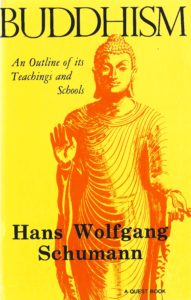Buddhism – An Outline of Its Teachings and Schools (Theravada, Mahayana, Vajrayana)
By Hans Wolfgang Schumann.
200 Pages | First Quest edition 1974 | Paperback | Quest Books, U.S.A. | ISBN: 0835604527.
WITH 39 DRAWINGS AND PHOTOS.
Both general readers and serious students of Buddhism will welcome the systematic arrangement of material, which makes this book a reliable guide through a vast field of thought. The author worked from original texts, and his work contains many original observations. Of special value is a Tabulated Synopsis of the major systems of Buddhism enabling the student to grasp, almost at a glance, the fine distinctions between them.
From its Preface:
" Five hundred years before the rise of Christianity there originated in India a religious doctrine, which does not make a god or the gods the subject of its thinking , but concentrates on man himself as interwoven with the cosmic cycle. As its author, Siddhattha Gotama, the 'Buddha', was convinced of having revealed in this teaching a natural law, he calls it 'the law' (p: dhamma, Skt: dharma), thereby simultaneously characterising it as a rule for human behaviour. Aptly, his followers chose the wheel (P: cakka, Skt: cakra) as symbol of the dharma: a symbol of functional unity, of pivotal standstill in movement and, in ancient India, of righteous royal rulership.
[...]
The twenty-four wheel symbol of the righteous ruler (cakkavatin) belongs to the lion-capital of the pillar erected in Sārnāth by Emperor Asoka in the 3rd century B.C. The edict carved in the pillar warns against schism of the monastic order. The lion-capital is today India's national coat of arms; the wheel was incorporated in the Indian national flag. As a Buddhist symbol, the 'wheel of the teaching' may have eight to thirty-six spokes. "
 Bezig met bijwerken...
Bezig met bijwerken...